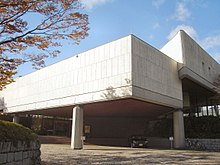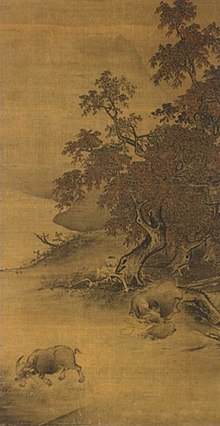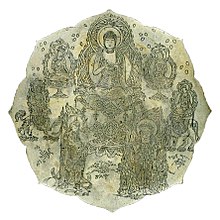Sen'oku Hakkokan
The Sen'oku Hakkokan ( Japanese 泉 屋 博古 館 ; also read Izumiya Hakkokan ) in Kyoto is a museum that houses the art collection of the Sumitomo family . It is known for its significant collection of Chinese art.
Overview
Among the art treasures of Sen'oku Hakkokan, the most famous part is the part of the collection that the 15th head of the house, Baron Sumitomo Tomoito ( 住友 友 純 ; 1865–1926), collected from around 1900 to the twenties, namely the ancient Chinese bronzes and the bronze mirror. Outside of China there is no such extensive collection of its kind as this one with over 500 objects. In 1960 the collection was transferred to a foundation, for which a gallery was opened in 1970, which comprises four halls. The name was Sen'oku Hakkokan chosen because the company name in the Edo period Izumi-ya (another reading of the character 泉屋 ) was and is handed an instruction by a Chinese emperor 900 years ago, a catalog of old valuable objects - zuroku Hakko ( 博古 図 録 ) - to be made.
In the period that followed, the family continued to donate art objects, so that the current collection comprises more than 3000 objects. For the growing collection, another building was completed in 1986 next to the building for the bronzes. In addition, a branch museum was opened in Tōkyō in 2002.
The collection (selection)
Bronze vessels
The majority of the bronze vessels date from the Yin and early Zhou dynasties . Some bronzes are from the middle Zhou Dynasty and a significant number from the Warring States Period and the Han Dynasty . The most famous piece is an intricately shaped vessel from the early West Zhou dynasty in the shape of a tiger holding a person. Almost as well known is a large drum (diameter 81 cm, weight 71 kg) from the late Shang dynasty with human faces on the sides. An armrest from the Shang dynasty is also exceptional. The collection is also known for its numerous bells from all periods (including a set of twelve bells from the Warring States Period ), its steam boilers, belt buckles and for the mirrors from the Han, Tang , Song and Korea periods.
Chinese mirrors
- Mirror with gods, dragons and tigers, 1st to 2nd century, 20 cm in diameter.
- Mirror with the four gods and four wild animals, 3rd century, 22 cm.
- Mirror with saints and wild animals, 3rd century, 16 cm.
- Mirror with animals and Chinese characters, 7th century, 19 cm.
- Silver-plated mirror with four animals, two phoenixes and flowers, 8th century, 25.5 cm.
Classical Chinese painting and calligraphy
Among the more than 100 Chinese paintings, a "landscape with water buffalo" from the Song period is registered as a national treasure. The majority of these paintings - a number is registered as an important cultural asset - come from the Ming Dynasty and Qing Dynasty with very good examples of the works of Wu Li ( 吳 歷 ; approx. 1632–1718), Shi Dao, Bada Shanren ( 八大山人 ; approx. 1626–1705), Yun Shouping ( 惲 壽 平 ; 1633–1690), Jian Jiang and Shen Hui, to name a few. There are also two good Buddhist paintings. The museum also has calligraphies by Zhao Mengfu , Wen Zhengming ( 文徵明 / 文征明 ; 1470–1559) and the emperors Kangxi and Qianlong .
Japanese contemporary painting
Since the 1980s, the collection has been expanded to include art of the 20th century and now also includes "Western Style Pictures" by Asai Chū , Wada Eisaku , Fujishima Takeji , Yamashita Shintarō , Kishida Ryūsei , Claude Monet and others. a. and in the "Japanese style" by Murata Kōkoku , Hashimoto Gahō , Hirafuku Hyakusui , Kanō Hōgai , Konoshima Ōkoku and Higashiyama Kaii u. a.
Buddhist art
A mirror with the image of the Buddha surrounded by disciples from the Heian period is registered as a national treasure. Among the gilded bronze Buddhas there is a Maitreya dated to the year 498. Another special piece is a miniature coffin as a reliquary container from the Tang period. He stands on an edged platform that is protected by four figures. Also from the Tang period is a cuboid reliquary container made of limestone with incised figures depicting Buddha's disciples.
Further stocks
Other stocks include
- Japanese calligraphy ,
- Japanese ceramics of the present,
- Devices for the tea ceremony ,
- Writing utensils,
- No masks ,
- Weapons and
- Old coins.
Remarks
- ↑ a b From the grave mound Kutsukawa Kurumazuka on the site of the city of Jōyō ( Important Cultural Property of Japan ).
literature
- Laurance P. Roberts: Sen-oku Hakkokan. In: Robert's Guide to Japanese Museums of Art and Archeology. Simul Press, 1987. ISBN 4-377-50737-0 .
Web links
Coordinates: 35 ° 11 ′ 33 " N , 135 ° 47 ′ 34" E


